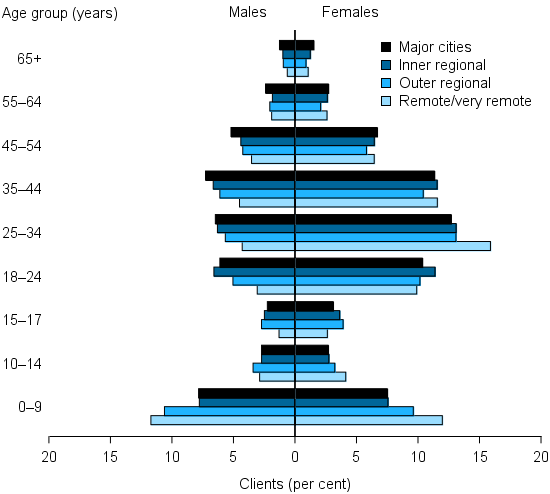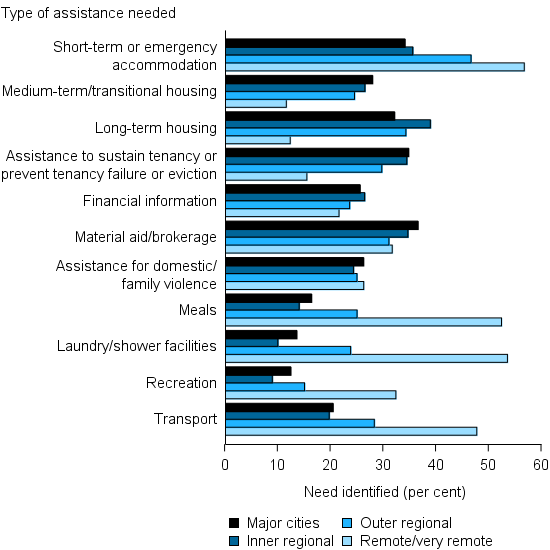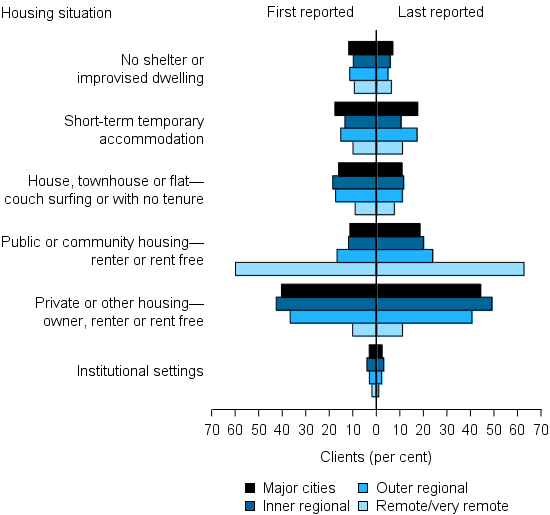Clients in regional and remote areas
Access to services can become increasingly difficult the further away a client is from a major city. This section examines differences in client characteristics and service needs according to location. Similar to previous reports, for the purposes of the analysis, clients have been classified by geographical area based on the location of the agency from which they first received assistance in 2014–15. Agencies have been classified by geographical area based on the Australian Statistical Geography Standard [1] using the location details of each agency.
Clients by geographic area: trends over time
Since the beginning of the Specialist Homelessness Services collection in 2011–12 there has been a steady increase in the number of clients across most geographic areas. The collection continues to reveal differences in client characteristics and service needs across these areas. Some key regional changes over the 4 years since the collection began have been:
- Taking into account population differences, Remote/Very remote areas consistently reported the highest rate of homelessness service use. These areas also showed the largest growth in the rate of service use, increasing by an average of 6.1% each year.
- The proportion of Indigenous clients in both the Outer regional and Remote/Very remote areas increased each year; in 2014–15 5 in 10 and 9 in 10 clients identified as Indigenous in these areas respectively.
- Domestic and family violence was the main reason why people sought assistance in all regional areas and has remained so over the 4 years of the collection.
| Year | Major cities | Inner regional | Outer regional | Remote/ Very remote | |
|---|---|---|---|---|---|
| Number of clients (proportion of all clients) | |||||
| 2014–15 | 162,286 (63%) | 52,061 (20%) | 28,257 (11%) | 13,053 (5%) | |
| 2013–14 | 159,877 (63%) | 55,510 (22%) | 26,785 (11%) | 11,831 (5%) | |
| 2012–13 | 151,255 (62%) | 54,547 (22%) | 26,693 (11%) | 11,682 (5%) | |
| 2011–12 | 144,710 (61%) | 53,694 (23%) | 27,379 (12%) | 10,647 (5%) | |
| Rate (per 10,000 population) | |||||
| 2014–15 | 98 | 122 | 136 | 245 | |
| 2013–14 | 98 | 132 | 130 | 222 | |
| 2012–13 | 95 | 131 | 130 | 222 | |
| 2011–12 | 92 | 131 | 135 | 206 | |
| Indigenous status | |||||
| 2014–15 | Indigenous | 14% | 21% | 48% | 89% |
| Non-Indigenous | 86% | 79% | 52% | 11% | |
| 2013–14 | Indigenous | 14% | 21% | 47% | 87% |
| Non-Indigenous | 86% | 79% | 53% | 13% | |
| 2012–13 | Indigenous | 14% | 21% | 45% | 81% |
| Non-Indigenous | 86% | 79% | 55% | 19% | |
| 2011–12 | Indigenous | 13% | 20% | 43% | 80% |
| Non-Indigenous | 87% | 80% | 57% | 20% | |
| Living arrangement | |||||
| 2014–15 | Lone person | 31% | 27% | 25% | 16% |
| Sole parent | 33% | 37% | 35% | 24% | |
| Couple with child/ren | 13% | 13% | 17% | 18% | |
| Couple without children | 5% | 6% | 6% | 6% | |
| Other family group | 18% | 17% | 18% | 36% | |
| 2013–14 | Lone person | 32% | 28% | 28% | 15% |
| Sole parent | 33% | 35% | 35% | 25% | |
| Couple with child/ren | 12% | 14% | 14% | 19% | |
| Couple without children | 5% | 6% | 6% | 7% | |
| Other family group | 17% | 18% | 17% | 34% | |
| 2012–13 | Lone person | 34% | 29% | 28% | 19% |
| Sole parent | 30% | 33% | 33% | 24% | |
| Couple with child/ren | 12% | 14% | 15% | 17% | |
| Couple without children | 5% | 6% | 6% | 7% | |
| Other family group | 18% | 18% | 18% | 33% | |
| 2011–12 | Lone person | 34% | 27% | 27% | 18% |
| Sole parent | 30% | 34% | 33% | 26% | |
| Couple with child/ren | 12% | 14% | 15% | 18% | |
| Couple without children | 5% | 6% | 6% | 7% | |
| Other family group | 19% | 19% | 19% | 31% | |
| Main reason for seeking assistance (Top 4) | |||||
| 2014–15 | Domestic and family violence | 25% | 23% | 25% | 34% |
| Housing crisis | 21% | 21% | 22% | 11% | |
| Financial difficulties | 12% | 16% | 8% | 9% | |
| Inadequate or inappropriate dwelling conditions |
10% | 10% | 11% | 10% | |
| 2013–14 | Domestic and family violence | 24% | 23% | 22% | *35% |
| Housing crisis | 17% | 14% | 15% | 8% | |
| Financial difficulties | 15% | 17% | 13% | *9% | |
| Inadequate or inappropriate dwelling conditions |
11% | 12% | 15% | *13% | |
| 2012–13 | Domestic and family violence | 22% | 23% | 21% | 37% |
| Housing crisis | 16% | 12% | 16% | 7% | |
| Financial difficulties | 15% | 21% | 12% | 11% | |
| Inadequate or inappropriate dwelling conditions |
10% | 11% | 15% | 8% | |
| 2011–12 | Domestic and family violence | 25% | 25% | 20% | 39% |
| Housing crisis | 14% | 12% | 12% | 6% | |
| Financial difficulties | 16% | 14% | 17% | 11% | |
| Inadequate or inappropriate dwelling conditions |
8% | 11% | 13% | 9% | |
| Housing situation at the beginning of first support period (all clients) | |||||
| 2014–15 | Homeless: At risk of homelessness | 45%: 55% | 42%: 58% | 43%: 57% | 29%: 71% |
| 2013–14 | Homeless: At risk of homelessness | *42%: 58% | *41%: 59% | *46%: 54% | 34%: 66% |
| 2012–13 | Homeless: At risk of homelessness | *43%: 57% | *41%: 59% | *50%: 50% | *36%: 64% |
| 2011–12 | Homeless: At risk of homelessness | 41%; 59% | 40%: 60% | 46%: 54% | 35%:65% |
| Proportion receiving accommodation (median (nights)) | |||||
| 2014–15 | 31% (48) | 29% (35) | 41% (21) | 58% (5) | |
| 2013–14 | 32% (49) | 29% (38) | 44% (20) | 63% (6) | |
| 2012–13 | 35% (45) | 30% (35) | 45% (22) | 65% (6) | |
| 2011–12 | 34% (48) | 32% (34) | 41% (21) | 67% (7) | |
| Number of support periods (average per client) | |||||
| 2014–15 | 273,256 (1.7) | 80,073 (1.5) | 41,700 (1.5) | 19,182 (1.5) | |
| 2013–14 | 263,720 (1.6) | 82,889 (1.5) | 38,884 (1.5) | 16,770 (1.4) | |
| 2012–13 | 251,763 (1.7) | 80,378 (1.5) | 37,955 (1.4) | 17,019 (1.5) | |
| 2011–12 | 216,744 (1.5) | 74,961 (1.4) | 38,009 (1.4) | 13,980 (1.3) | |
| Average (median) length of support (days) | |||||
| 2014–15 | 79 (32) | 72 (39) | 72 (36) | 64 (17) | |
| 2013–14 | 83 (31) | 81 (42) | 71 (31) | 72 (21) | |
| 2012–13 | 89 (31) | 79 (36) | 75 (32) | 74 (17) | |
| 2011–12 | 86 (30) | 74 (33) | 64 (22) | 64 (15) | |
| Proportion of a client group who had a case management plan | |||||
| 2014–15 | 58% | 61% | 73% | 62% | |
| 2013–14 | *55% | *62% | *65% | *66% | |
| 2012–13 | *53% | *57% | *64% | *59% | |
| 2011–12 | 55% | 57% | 61% | 60% | |
| Achievement of all case management goals | |||||
| 2014–15 | 27% | 18% | 30% | 29% | |
| 2013–14 | *27% | *16% | *21% | *27% | |
| 2012–13 | 26% | 15% | 19% | 21% | |
| 2011–12 | 24% | 16% | 22% | 23% | |
Notes
-
Rates are crude rates based on the Australian estimated resident population (ERP) at 30 June of the reference year.
-
* Indicates where previously published data have been revised to ensure consistent reporting over time. 2011–12 data were revised in December 2013 but not previously reported in this format.
-
The denominator for the proportion achieving all case management goals is the number of client groups with a case management plan. Denominator values for proportions are provided in the relevant national supplementary table.
Source: Specialist homelessness services Annual Reports 2011–12, 2012–13, 2013–14 and 2014–15.
In 2014–15 changes occurred in the way agencies are required to report 'main reason' and 'reasons for seeking assistance'. Comparisons over time should be made with caution as the reporting of housing crisis, financial difficulties and housing affordability stress may be inconsistent between agencies. See Technical information for further details.
- In 2014–15 a large proportion of clients accessing specialist homelessness services lived in Major cities (63%). This is slightly lower than for the broader Australian population, 70% of whom live in Major cities (AIHW analysis of the ABS 2011 Census).
- Some client groups were more likely to access specialist homelessness services in Major cities. For example, in 2014–15 70% of SHS clients with a current mental health issue and 87% of SHS clients born overseas accessed specialist homelessness services in Major cities.
- A higher proportion of clients of homelessness services in 2014–15 were located in Remote/Very remote areas (5%) compared with the general population (2%). Almost 9 in 10 clients in Remote/Very remote areas were Indigenous (89%).
- The proportion of clients living in Remote/Very remote areas who were homeless upon presentation decreased from 34% in 2013–14 to 29% in 2014–15 (Table 1).
- Accommodation length varied considerably across regional areas. In 2014–15 over half of the clients in Major cities received 48 or more nights accommodation while less than half of the clients in Remote/Very remote areas received 5 or fewer nights.
Age and sex
About 1 in 4 clients
in Remote/Very remote areas were children under the age of 10.
- In all remoteness areas, there were more females than male clients (Figure REG.1). The proportion of females increased as remoteness increased. Females represented 59% of clients in Major cities compared with 66% of clients in Remote/Very remote areas.
- Clients aged between 25 and 34 represented the largest proportion across Major cities and Inner regional areas (18%, 20%, respectively) but clients aged between 0–9 represented the largest proportion in both Outer regional and Remote/Very remote areas (20%, 24%, respectively).
- The proportion of younger children (aged 0–9) generally increased with remoteness: from 15% of clients in Major cities to 24% of clients in Remote/Very remote areas.
- Together these data suggest that in Remote/Very remote areas there were higher proportions of families presenting with children compared with Major cities while the proportion of lone persons was higher in Major cities.
Figure REG.1: Clients, by remoteness area and by age and sex, 2014–15

Source: Specialist homelessness services 2014–15, National supplementary table REG.1 (702KB XLS).
Services needed and provided
57%
of clients accessing agencies located in Remote/Very remote areas required short-term or emergency accommodation.
- The likelihood of receiving accommodation decreased as remoteness decreased, with clients accessing agencies in Major cities and Inner regional areas the least likely to receive accommodation (59% and 51%, respectively) while those clients in Remote/Very remote areas with accommodation needs the most likely to have them met (87%).
- Clients accessing agencies located in Remote/Very remote areas were assessed with more needs compared with clients in other areas (Figure REG.2).
- Trends for clients accessing services in Inner regional areas were generally similar to those in Major cities. However, a higher proportion of clients accessing services in Inner regional areas were likely to need long-term housing (39% compared with 32% in Major cities).
- Clients accessing services in Major cities were more likely to be assessed as needing mental health services (8%) than those in any other region (between 2% and 7%).
Figure REG.2: Most needed services by remoteness area, 2014–15

Note: Most needed excludes 'Other basic assistance'.
Source: Specialist homelessness services 2014–15, National supplementary table REG.3 (702KB XLS).
Housing outcomes
- Clients accessing services in Major cities were the least likely to report ending support in stable housing (65%), with most living in private or other housing as a renter or rent free (44%) (Figure REG.3).
- Inner regional clients were the most likely to be housed in private or other housing at the end of their support period (49%).
- Those clients accessing agencies in Remote/Very remote areas were more likely to report living in public or community housing (60%) at the beginning of their support period. These clients were also the most likely to be classified as housed at the end of their support period (75%).
Figure REG.3: Clients with closed support, by remoteness area and housing situation at beginning of support and at end of support, 2014–15

Source: Specialist homelessness services 2014–15, National supplementary table REG.4 (702KB XLS).
Reference
- Australian Bureau of Statistics (ABS), 2013. Australian Statistical Geography Standard (ASGS): Volume 5—Remoteness structure, July 2011. ABS cat. no. 1270.0.55.005. Canberra: ABS.


